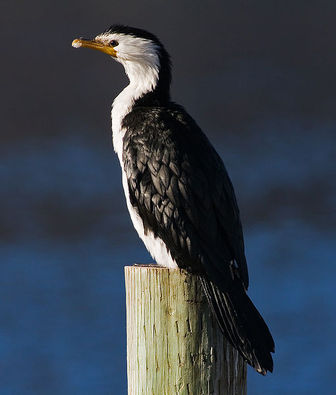Little Pied Cormorant
The Little Pied Cormorant, Little Shag or Kawaupaka is a common Australasian waterbird, found around the coasts, islands, estuaries, and inland waters of Australia, New Guinea, New Zealand, Malaysia, and Indonesia, and around the islands of the south-western Pacific and the sub-Antarctic. It is a small short-billed cormorant usually black above and white below with a yellow bill and small crest, although a mostly black white-throated form predominates in New Zealand. Three subspecies are recognised. Until recently most authorities referred to this species as Phalacrocorax melanoleucus.

Original source: Own work
Author: JJ Harrison (http://www.noodlesnacks.com/)Camera location
Permission: GNU Free Documentation License
The Little Pied Cormorant is classified as Least Concern. Does not qualify for a more at risk category. Widespread and abundant taxa are included in this category.
Little Pied Cormorants feed on a wide variety of aquatic animals, from insects to fish. On inland streams and dams they turn to their most favoured food: yabbies (freshwater crayfish). These are caught by deep underwater dives with both feet kicking outward in unison. Other crustaceans are also taken, with shrimps being a large part of their diet in winter months. Mating and reproduction Little Pied Cormorants breed either in colonies or, less commonly, in single pairs. More
The Little Pied Cormorant is one of the most common of Australia's waterbirds, occurring on water bodies of almost any size. It is entirely black above and white below. The face is dusky and, in adult birds, the white of the underside extends to above the eye. Immature birds resemble the adults except there is no white above the eye. More
The species is known as the Little Pied Cormorant in Australia, and as the Little Shag or by the Maori name of Kawaupaka in New Zealand. The term White-throated Shag is also reserved for the melanistic form there. The Little Pied Cormorant was originally described by French naturalist Louis Jean Pierre Vieillot in 1817. Its specific epithet is derived from the Ancient Greek words melano- "black", and leukos "white". More
Description: The Little Pied Cormorant Phalacrocorax melanoleucos, at 55-60 cm long, is the smallest and most widely dispersed Australian Cormorant. They have a yellow sided stubby bill and white eyebrows above their brown eye. The black crown feathers extend to a spiky crest in the breeding season. Their white chest and upper legs contrast with the black feathers on their back and tail. Their webbed feet and legs are also black. The female is similar but slightly smaller than to the male. More
The Little Pied Cormorant is found throughout Australia. Habitat The Little Pied Cormorant is at home in either fresh or salt water. It is often seen in large flocks on open waterways and on the coast, especially where large numbers of fish are present. On inland streams and dams, however, it is often solitary. The Little Pied Cormorant mixes readily with the similar sized Little Black Cormorant, P. sulcirostris. More
The Little Pied Cormorant is a benthic feeder, i.e. it finds its prey on the sea floor. It feeds in relatively shallow water, often near the shore. Dive times are short, around 15 to 20 seconds, with recovery times on the surface of 5 to 10 seconds unless prey are being swallowed. In New Zealand waters it mostly eats the local flounder and other small flatfish. More

Original source: Arthur Chapman
Author: Arthur Chapman
Permission: Some rights reserved
Family : Phalacrocoracidae
Genus : Phalacrocorax
Species : melanoleucos
Authority : (Vieillot, 1817)
